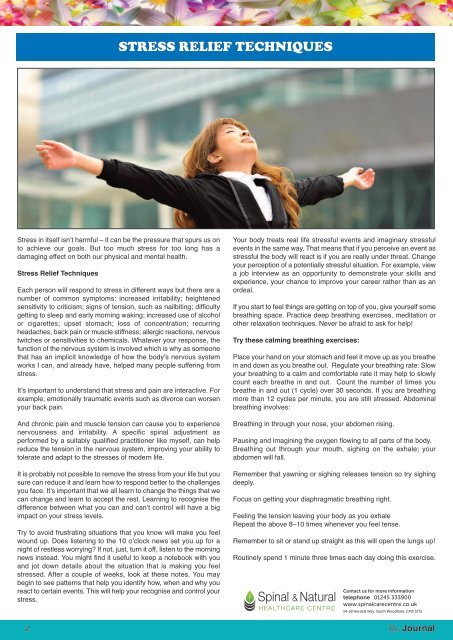DanAUG
Create successful ePaper yourself
Turn your PDF publications into a flip-book with our unique Google optimized e-Paper software.
The Negative Effects Computers Can Have on Children<br />
STRESS RELIEF TECHNIQUES<br />
Stress in itself isn’t harmful – it can be the pressure that spurs us on<br />
to achieve our goals. But too much stress for too long has a<br />
damaging effect on both our physical and mental health.<br />
Stress Relief Techniques<br />
Each person will respond to stress in different ways but there are a<br />
number of common symptoms: increased irritability; heightened<br />
sensitivity to criticism; signs of tension, such as nailbiting; difficulty<br />
getting to sleep and early morning waking; increased use of alcohol<br />
or cigarettes; upset stomach; loss of concentration; recurring<br />
headaches, back pain or muscle stiffness; allergic reactions, nervous<br />
twitches or sensitivities to chemicals. Whatever your response, the<br />
function of the nervous system is involved which is why as someone<br />
that has an implicit knowledge of how the body’s nervous system<br />
works I can, and already have, helped many people suffering from<br />
stress.<br />
It’s important to understand that stress and pain are interactive. For<br />
example, emotionally traumatic events such as divorce can worsen<br />
your back pain.<br />
And chronic pain and muscle tension can cause you to experience<br />
nervousness and irritability. A specific spinal adjustment as<br />
performed by a suitably qualified practitioner like myself, can help<br />
reduce the tension in the nervous system, improving your ability to<br />
tolerate and adapt to the stresses of modern life.<br />
It is probably not possible to remove the stress from your life but you<br />
sure can reduce it and learn how to respond better to the challenges<br />
you face. It’s important that we all learn to change the things that we<br />
can change and learn to accept the rest. Learning to recognise the<br />
difference between what you can and can’t control will have a big<br />
impact on your stress levels.<br />
Try to avoid frustrating situations that you know will make you feel<br />
wound up. Does listening to the 10 o’clock news set you up for a<br />
night of restless worrying? If not, just, turn it off, listen to the morning<br />
news instead. You might find it useful to keep a notebook with you<br />
and jot down details about the situation that is making you feel<br />
stressed. After a couple of weeks, look at these notes. You may<br />
begin to see patterns that help you identify how, when and why you<br />
react to certain events. This will help your recognise and control your<br />
stress.<br />
Your body treats real life stressful events and imaginary stressful<br />
events in the same way. That means that if you perceive an event as<br />
stressful the body will react is if you are really under threat. Change<br />
your perception of a potentially stressful situation. For example, view<br />
a job interview as an opportunity to demonstrate your skills and<br />
experience, your chance to improve your career rather than as an<br />
ordeal.<br />
If you start to feel things are getting on top of you, give yourself some<br />
breathing space. Practice deep breathing exercises, meditation or<br />
other relaxation techniques. Never be afraid to ask for help!<br />
Try these calming breathing exercises:<br />
Place your hand on your stomach and feel it move up as you breathe<br />
in and down as you breathe out. Regulate your breathing rate: Slow<br />
your breathing to a calm and comfortable rate it may help to slowly<br />
count each breathe in and out. Count the number of times you<br />
breathe in and out (1 cycle) over 30 seconds. If you are breathing<br />
more than 12 cycles per minute, you are still stressed. Abdominal<br />
breathing involves:<br />
Breathing in through your nose, your abdomen rising.<br />
Pausing and imagining the oxygen flowing to all parts of the body.<br />
Breathing out through your mouth, sighing on the exhale; your<br />
abdomen will fall.<br />
Remember that yawning or sighing releases tension so try sighing<br />
deeply.<br />
Focus on getting your diaphragmatic breathing right.<br />
Feeling the tension leaving your body as you exhale<br />
Repeat the above 8–10 times whenever you feel tense.<br />
Remember to sit or stand up straight as this will open the lungs up!<br />
Routinely spend 1 minute three times each day doing this exercise.<br />
Contact us for more information<br />
telephone 01245 333900<br />
www.spinalcarecentre.co.uk<br />
14-18 Heralds Way, South Woodham, CM3 5TQ<br />
2 The Journal


















